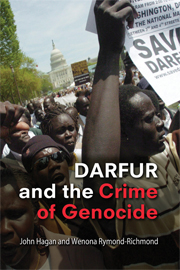Book contents
- Frontmatter
- Contents
- Glossary
- List of Characters
- Prologue: On Our Watch
- Darfur and the Crime of Genocide
- Settlement Cluster Map of Darfur, Sudan
- 1 Darfur Crime Scenes
- 2 The Crime of Crimes
- 3 While Criminology Slept with Heather Schoenfeld
- 4 Flip-Flopping on Darfur with Alberto Palloni and Patricia Parker
- 5 Eyewitnessing Genocide
- 6 The Rolling Genocide
- 7 The Racial Spark
- 8 Global Shadows
- Epilogue: Collective R2P
- Appendix: Genocidal Statistics
- Notes
- Index
- Titles in the series
3 - While Criminology Slept with Heather Schoenfeld
Published online by Cambridge University Press: 05 June 2012
- Frontmatter
- Contents
- Glossary
- List of Characters
- Prologue: On Our Watch
- Darfur and the Crime of Genocide
- Settlement Cluster Map of Darfur, Sudan
- 1 Darfur Crime Scenes
- 2 The Crime of Crimes
- 3 While Criminology Slept with Heather Schoenfeld
- 4 Flip-Flopping on Darfur with Alberto Palloni and Patricia Parker
- 5 Eyewitnessing Genocide
- 6 The Rolling Genocide
- 7 The Racial Spark
- 8 Global Shadows
- Epilogue: Collective R2P
- Appendix: Genocidal Statistics
- Notes
- Index
- Titles in the series
Summary
Finding the Victims
From Vietnam to civil rights and baseball, there is perhaps no more revered chronicler of recent American history than the late David Halberstam. So it is striking that the index of Halberstam's exhaustive account, The Fifties, does not contain a single entry for international criminal law, war crimes, Nuremberg, or the Holocaust. Americans in the middle years of the twentieth century simply gave little thought to these issues. Criminologists joined other Americans in moving on with the postwar baby boom and its concerns about the next generation's rather than the last generation's problems. In the case of criminology, this meant a preoccupation with postwar adolescence and the problems of juvenile delinquency. Edwin Sutherland's student Albert Cohen spoke to these new concerns with his landmark book, Delinquent Boys, and Sheldon Glueck began and ended the decade with research monographs on delinquency. Audiences flocked to see West Side Story and Rebel without a Cause. Americans in the immediate postwar period feared the threats posed by communism and delinquency more than crimes against humanity and genocide.
Yet, Sutherland awakened Americans to new problems of white-collar crime. At about the same time, Sutherland's neighbor and colleague at Indiana University in Bloomington, Alfred Kinsey, fascinated Americans with his interviews with samples of college students and adults about their sexual behavior. This work provided an entertaining as well as informative diversion from memories of World War II; it also popularized new social scientific methods of population sampling and survey research.
- Type
- Chapter
- Information
- Darfur and the Crime of Genocide , pp. 57 - 78Publisher: Cambridge University PressPrint publication year: 2008
- 1
- Cited by



